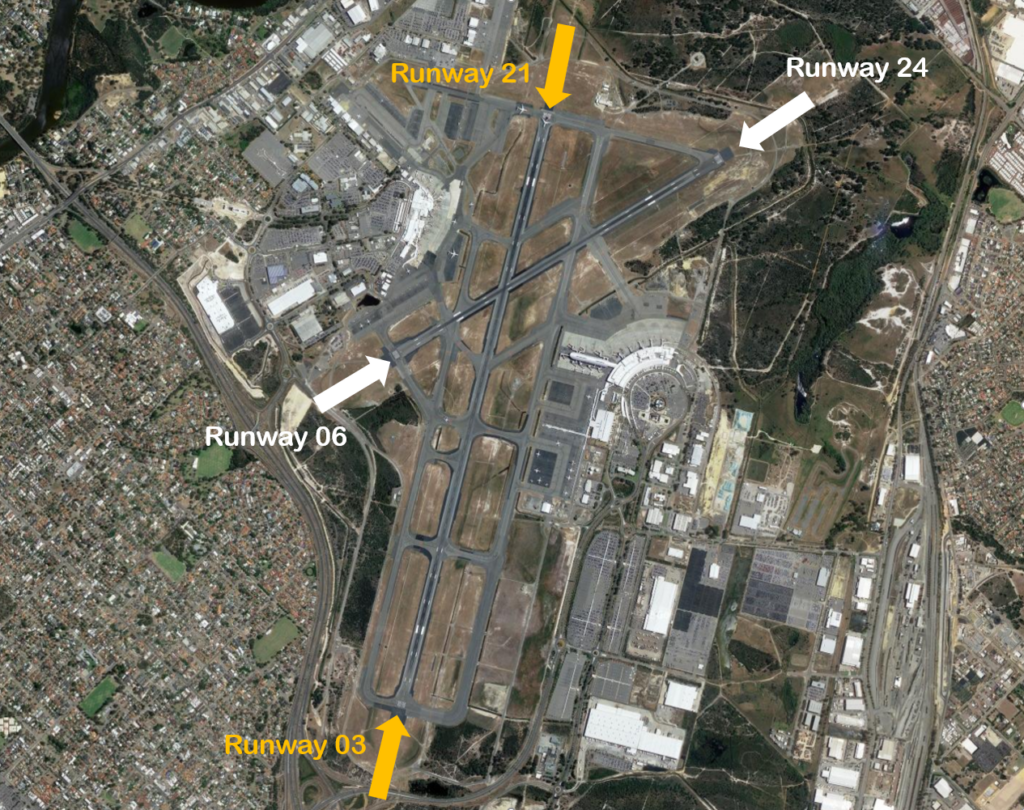Perth Airport Runways
Perth Airport has two runways; the main runway 03/21 (3.4 km long) is orientated approximately north-south and the smaller cross runway 06/24 (2.2km) is orientated south-west to north-east.
Each runway is referred to differently according to in which direction it is being used. For example the main runway is known as Runway 03 when used in a northerly direction and Runway 21 when used in a southerly direction. Runway numbering reflects the runways’ orientation and correlates with degrees on a compass. Runway 21 is 210 degrees.
An Instrument Landing System operates for aircraft landing on Runways 03,21 and 24, and non-precision approaches are available to all runways.

The following video explains how runways are named and used.
Runway selection and seasonal winds
Runway selection is based on wind direction, weather conditions, traffic volume and other factors. Aircraft primarily take-off and land into the wind for safety and performance reasons. Therefore, as the wind direction changes the runway in operation may also change depending on the strength of the wind.
This means that Perth’s seasonal wind patterns affect usage of the different runway directions. Specifically, Runway 21 tends to be used more frequently in the warmer months due to southerly winds whereas Runway 03 tends to be used more frequently in the cooler months when the predominant wind direction tends to be northerly.
Runways may be used in combination. For example, Runways 03 and 06 may be used at the same time for departures, or Runways 21 and 24 may be used at the same time for arrivals.
Runway use in peak periods
One of the factors taken into account in runway selection is operational requirements. For example, two operational factors make Runway 21 a more suitable choice for departures during peak periods. Firstly, the location of the terminals and hangars in relation to the runways means that departing aircraft can be moved to Runway 21 more efficiently than to other runways. Secondly, because there is so much military restricted airspace to the north of Perth Airport, there is more airspace available to the south in which to manage the mix of slow and fast aircraft in the air after departure. Both these factors become critically important when the volume of traffic is high. For these reasons, Runway 21 will usually be selected in peak periods if the wind allows it. Therefore it can be expected that Runway 21 will be used whenever possible for the morning departure burst which is the busiest period at Perth Airport. This begins around 5 am.
Noise abatement procedures
Noise abatement procedures are designed to help reduce the impact of aircraft noise on communities. While they are applied whenever it is possible to do so, their use is not mandatory and is subject to weather conditions and traffic requirements.
The Perth Airport Noise Abatement Procedures (NAP) state that all runways are equally preferred for arrivals and departures with the exception of Runway 06 for landing and Runway 24 for departures. This is due to the very close proximity of residential areas to this end of the crossing runway. This runway end is used on occasion however, for example when there is too much crosswind to use the main runway, and when the main runway is unavailable for reasons such as runway works.
Although the NAP state the other runways are equally preferred, this does not mean that they are equally used – rather that there is no preference in the use of the runways from a noise abatement perspective and the weather and operational requirements will determine the preferred runway.
The procedures also provide that:
- aircraft departing towards the north and turning east of Perth are to be kept on the Standard Instrument Departure track until leaving 8000 feet, unless there is an operational reason not to do so
- departing aircraft will usually be given a Standard Instrument Departure (SID) but where this is not possible the route given will approximate the SID as closely as possible
- arriving aircraft flying under instrument flight rules (IFR) must be given Standard Arrival Routes (STAR) where available. Any non-STAR tracking must approximate the STAR as closely as possible except in some specific circumstances


